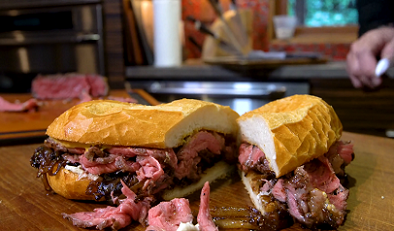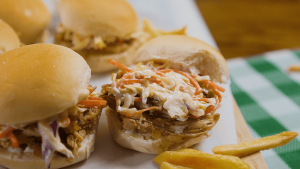
How To Make Sous Vide French Dip Sandwiches
These French dip sandwiches are a great introductory dish for trying sous vide, a method of cooking that involves vacuum sealing and low temperatures.
Serves:
Ingredients
- 3lbsbeef top,or bottom round roast, boneless
- 1tspsalt,plus more to taste
- ¼tspblack pepper,plus more to taste
- 3tbspcooking oil,(like canola or grapeseed)
- ½cupred wine
- 2cupslow sodium beef broth,or stock
- 1bay leaf
For Serving:
- 1largeyellow onion,(or 2 small yellow onions), thinly sliced
- 8french rolls,or hoagie buns
- provolone cheese,sliced, optional
Instructions
-
Trim any large pieces of fat from the exterior of the roast. Season it on all sides with salt and pepper.
-
Warm a large skillet over medium-high heat and add 1 tablespoon of oil. When the oil shimmers and glides smoothly, and a flick of water evaporates on contact with the pan, add the roast.
-
Sear the roast very well on all sides, 4 to 5 minutes per side. The seared surfaces should look dark reddish-brown. If the oil starts to get smoky, lower the heat slightly; otherwise, maintain a medium-high heat for the best sear.
-
Transfer the seared beef to a plate to cool slightly.
-
With the pan still over medium-high heat, add the wine all at once. It will bubble and steam as it hits the pan. As it bubbles, use a stiff spatula to scrape up any dark bits that were stuck.
-
Once all the bits are scraped up and the wine is simmering, pour it carefully into a measuring cup. Let it cool slightly.
-
Place a 1-gallon plastic freezer bag on your counter and fold the top outwards to form a cuff; this will help it stand up and make it easier to fill. (Alternatively, place the bag in a bowl while filling).
-
Place the slightly cooled roast into the bag. Pour the wine and broth over top, and tuck the bay leaf inside. Zip the bag almost entirely shut, leaving about an inch open at one edge.
-
Fill a large stockpot three-quarters full with water. Submerge the bag with the roast until just the zipper part of the bag is above the water. As the bag is submerged, the pressure of the water will press the sides of the plastic bag up against the roast and the liquid, “hugging” the ingredients. Use hands or a spatula to poke the roast below the surface of the water and force out any bubbles.
-
Once all the air bubbles are out, submerge the bag up to the zipper, then zip it all the way closed so the bag is sealed. Lift the roast from the water and place it on a dishtowel while heating the water.
-
Place the pot of water on a trivet or other heatproof surface. Place the immersion circulator in the water and set it to heat the water based on preferred doneness for the roast beef: 135 degrees F (medium-rare), 140 degrees F (medium), 145 degrees F (medium-well) or 150 degrees F (well-done).
-
Once the water has finished heating, lower the roast into the water. It’s fine if the zipper is above the surface of the water, but the roast itself should be completely submerged by at least an inch or so. Add more water if needed.
-
Cook the roast for 18 to 24 hours. It will become more tender the longer it cooks.
-
Every so often during cooking, take a peek at the roast and make sure that it’s still submerged in the water and the bag isn’t leaking. Keep an eye on the water level and add additional water if it looks like it’s getting low. The immersion circulator will heat the water right back up to temperature. To help prevent evaporation, the pot can also be covered with plastic wrap, a silicon bowl cover, or any other cover.
-
At any point during this cooking time, cook the onions. Warm a teaspoon or two of oil in a skillet and cook the onions with salt until they are very soft and browned.
-
When done cooking the roast, lift the bag from the water and set it on a kitchen towel on the counter. Warm a tablespoon of oil in a large skillet over medium-high heat.
-
Open the bag with the roast; be careful not to spill any of the cooking liquid. Use tongs to lift the roast from the bag and transfer it to a cutting board. Pat it dry on all sides.
-
Transfer the roast to the hot skillet and sear on all sides, 2 to 3 minutes per side, until the outside is very crusty. Add more oil as needed to the pan. Once seared, set the roast on a cutting board until ready to slice.
-
While the roast sears, strain the cooking liquid (“jus”) into a measuring cup. Taste and add salt or pepper if needed. If the jus seems overly concentrated, add a little water to thin it out again.
-
Use a little of the jus to deglaze the pan after searing the roast, if desired. Transfer the jus to individual cups for serving.
-
Warm the oven to 400 degrees F. Open up all the French rolls and arrange them in a single layer on a baking sheet with the cut sides facing up. Toast in the hot oven until they are warm and feel crispy when the surface is pressed. This will take about 5 minutes. Remove from the oven, but leave the oven on.
-
Use a sharp chef’s knife and slice the beef against the grain as thinly as possible.
-
Pile slices of beef on the bottom half of the rolls. The meat should divide equally between all the rolls.
-
Top each pile of beef with some onions and a slice or two of cheese, if desired.
-
Set aside the tops of the buns so they don’t burn. Switch the oven to “broil” and slide the pan of sandwiches under the broiler. Broil for about 1 minute until the cheese starts to melt.
-
Top each sandwich with the top bun. Serve with the jus alongside for dipping.
-
Refrigerate leftovers and consume within 3 to 4 days, or freeze for up to 3 months.
Nutrition
- Calories: 401.05kcal
- Fat: 15.15g
- Saturated Fat: 4.17g
- Trans Fat: 0.45g
- Monounsaturated Fat: 8.37g
- Polyunsaturated Fat: 2.33g
- Carbohydrates: 22.25g
- Fiber: 1.58g
- Sugar: 1.33g
- Protein: 41.49g
- Cholesterol: 107.16mg
- Sodium: 713.84mg
- Calcium: 68.16mg
- Potassium: 836.48mg
- Iron: 4.90mg
- Vitamin A: 3.66µg
- Vitamin C: 1.42mg
Was this page helpful?
Have your own special recipe to share? Submit Your Recipe Today!











